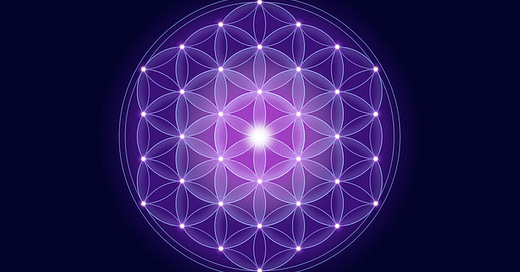The Flower of Life: An Ancient Symbol of Unity and Creation
Sacred Geometry: The Mathematical Foundations of the Universe
Photo from Mandalasforthesoul
In the realm of sacred geometry, few symbols are as universally revered and enigmatic as the Flower of Life. This intricate and beautiful pattern, composed of overlapping circles, transcends cultural and temporal boundaries, offering profound insights into the fabric of existence and the interconnectedness of all life. Found in various cultures and historical periods, this symbol is more than a beautiful design; it represents the fundamental structure of the universe and the interconnectedness of all life. Its presence in locations such as the Temple of Osiris in Egypt and the Forbidden City in China highlights its universal significance. Today, the Flower of Life continues to inspire, serving as a powerful tool in meditation and spiritual practices.
A Geometrical Marvel
At its core, the Flower of Life is a geometrical figure consisting of multiple evenly spaced, overlapping circles arranged in a flower-like pattern with six-fold symmetry. The design is both simple and complex, radiating harmony and balance. When extended, the pattern can continue infinitely, creating a vast web of interlocking circles that mesmerize the eye and engage the mind.
Historical Roots
The Flower of Life is not a modern invention; its roots extend deep into antiquity. One of the most famous ancient depictions of this symbol can be found at the Temple of Osiris in Abydos, Egypt, where it is etched into the granite walls with precision that speaks to a sophisticated understanding of geometry. Similar patterns have been discovered in the Forbidden City of China, in Phoenician and Assyrian ruins, and even in medieval European churches. These widespread occurrences suggest a shared recognition of its significance across different civilizations.
Spiritual and Symbolic Significance
The Flower of Life holds a wealth of spiritual and symbolic meanings, often seen as a visual expression of the interconnectedness of all life. The overlapping circles represent the fundamental structure of the universe, embodying concepts of creation, unity, and the cyclical nature of existence.
Creation and Unity
In many spiritual traditions, the Flower of Life is seen as a blueprint for creation. The interlocking circles symbolize the interconnectedness of all beings and phenomena, reflecting the idea that everything in the universe is linked. This pattern is often used to illustrate the concept of unity, where each individual part contributes to the whole, creating a cohesive and harmonious structure.
Sacred Geometry
Sacred geometry refers to geometric shapes and patterns that hold spiritual significance and are believed to be the building blocks of the cosmos. The Flower of Life is a quintessential example of this, embodying principles such as the golden ratio and the Fibonacci sequence. These mathematical concepts are found in natural phenomena, from the spirals of galaxies to the patterns of seashells, suggesting a universal language of creation.
Metaphysical Beliefs
Beyond its historical and geometrical significance, the Flower of Life is imbued with metaphysical properties. In New Age spirituality and various metaphysical practices, this symbol is used as a tool for meditation, healing, and personal growth. It is believed to emit a harmonious energy that can help balance the mind, body, and spirit, promoting overall well-being.
Practitioners of sacred geometry often meditate on the Flower of Life to gain insights into the nature of reality and their place within it. The symbol serves as a reminder of the infinite potential and interconnectedness inherent in all life, encouraging a deeper understanding of the self and the universe.
Connection to Other Symbols
Within the Flower of Life pattern, one can discern other significant geometrical shapes, each with its own unique meaning. The Seed of Life, formed by seven interlocking circles, represents the seven days of creation and the foundation of life itself. The Egg of Life, a three-dimensional arrangement of circles, symbolizes the embryonic development of living organisms. The Fruit of Life, consisting of thirteen circles, is often associated with the structure of the universe and the underlying framework of existence.
Perhaps the most profound derivative is the Tree of Life, a symbol deeply rooted in various mystical traditions, including Kabbalah. The Tree of Life represents the interconnectedness of all aspects of life, from the earthly to the divine, and serves as a map for spiritual ascension and enlightenment.
Contemporary Relevance
Today, the Flower of Life continues to captivate and inspire. It is a popular motif in art, architecture, and design, symbolizing harmony, balance, and the eternal dance of creation. Modern spiritual seekers and practitioners of sacred geometry embrace it as a tool for meditation and a gateway to deeper understanding.
In a world that often feels fragmented and chaotic, the Flower of Life offers a reminder of the inherent unity and interconnectedness of all things. It invites us to recognize the beauty and harmony that underlie the fabric of existence, encouraging us to live in a way that honours and reflects these principles.
In conclusion, the Flower of Life is a captivating symbol that transcends time and culture, offering profound insights into the interconnectedness of existence. Its intricate geometry not only pleases the eye but also embodies deep spiritual truths and universal principles. From ancient temples to modern art, this symbol continues to inspire and enlighten those who encounter it. By reflecting on the Flower of Life, we are reminded of the unity that underpins all of creation and the endless potential for harmony within our lives. As we appreciate its beauty and significance, we are encouraged to seek deeper understanding and connection in our own journeys.
As always, feel free to reach out with any questions or comments. Happy musing!




